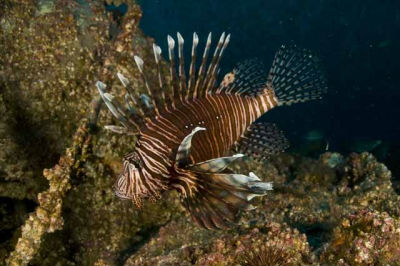Final of two stories
“Severe reactions include nausea, vomiting, abdominal cramps, tremors, abnormal heart rhythms, weakness, shortness of breath, seizures, decreased blood pressure, fainting and paralysis. Death may occur.”
Supporter Spotlight
But that’s only if they sting you.
Those symptoms are listed by Atlantis Charters Diving and Fishing Adventures in Atlantic Beach as a warning for divers encountering lionfish. Poisonous, stinging spines and the swiftness at which this invasive species has populated North Carolina waters make lionfish a menace.
 With careful handling, lionfish have a mild flavor similar to that of pink snapper. Photo: Discovery Diving |
When lionfish are dressed and cooked, however, the only danger is eating too many.
“They remind me a lot of trigger fish,” Bistro By the Sea restaurant owner Libby Eaton of Morehead City told the Charlotte Observer of lionfish’s delicate taste when she helped arrange the inaugural “If You Can’t Beat ’Em, Eat ’Em” lionfish spearfishing tournament off Morehead City (see June 24 Coastal Review Online for the first story in the series).
The April 2013 event encouraged divers to hunt lionfish and featured the catch’s tasty rewards.
Supporter Spotlight
Native to the South Pacific and Indian oceans, lionfish were once mere saltwater fish tank curiosities, especially in America. The white-and-maroon-striped fish were first sighted off North Carolina in 2000. The National Oceanic and Atmospheric Administration reported that lionfish showed up off the U.S. East Coast in the 1990s.
Lionfish have since established themselves from North Carolina to Florida, even down to South America and north to New England, NOAA discovered. Many researchers blame the aquarium trade for the lionfish invasion.
How lionfish populations exploded so widely and rapidly is an ongoing debate, but researchers agree the invasive species’ numbers will continue to grow, posing harm to humans and marine environments.
Lionfish stings threaten divers and swimmers. Plus, “Not only are they voracious predators that out-compete many other species for food resources, but they also have few known natural predators of their own,” NOAA reported.
Although lionfish are venomous, their meat is safe to eat.
Despite their great numbers, lionfish are difficult to find at retail markets. Mainly taken recreationally, the best way to source them may be by getting to know divers or bottom-fishing anglers. Lionfish rarely bite a hook; most are speared or trapped in hand-held nets, the Florida Fish and Wildlife Conservation Commission advised.
Diners who get lionfish will be rewarded with moist, mild-flavored meat that recipe testers for the N.C. State University Seafood Laboratory found to be similar in texture and flavor to pink snapper.
Southeast coast divers encounter so many lionfish that many of them have contributed recipes to various publications, including the Lionfish Hunter Website, which boasts the “largest collection of lionfish recipes anywhere.”
Also, look for the “Lionfish Cookbook” by chef Tricia Ferguson and REEF executive director Lad Akins.
REEF, or Reef Environmental Education Foundation, is a Key Largo, Fla., grass-roots, non-profit organization of recreational divers committed to ocean conservation. Proceeds from the cookbook’s sales benefit REEF.
Cooks dressing fresh lionfish must watch the fish’s spines. Touching them is OK, but if the spines pierce the skin, their toxin is released, Akins warns in a “Changing Seas” South Florida Public Television series video demonstrating how to trim, skin and filet the fish .
Lionfish may be baked, broiled, sautéed, battered or breaded and fried, served raw or prepared as ceviche.
Diners who would rather leave the cooking to professional chefs may find local restaurants that serve lionfish, said Amanda Miller, founder of Dock to Door Seafood, a wholesaler focused on sustainable and unconventional species.
Miller sourced lionfish once from Haag and Sons Seafood in Oak Island.
“It’s very difficult and very dangerous to harvest, so it’s hard to get any on a regular basis,” Miller said. “I only got 50 pounds once, and two restaurants purchased all 50 pounds and are ready for more.”
“I’ve had some people say ‘They’re so weird-looking. How do you eat that?” Miller said.
Consider these recipes:
Broiled Lionfish with Garlic Basil Butter
 Broiled Lionfish Photo: North Carolina Sea Grant |
For the Garlic Basil Butter:
½ cup margarine or butter, softened
1 teaspoon pressed garlic
1 teaspoon finely chopped fresh basil
1 teaspoon fresh lemon juice
1/8 teaspoon salt
For the fish:
6 small lionfish fillets
2 tablespoons margarine or butter, melted
Salt
Freshly ground black pepper
Prepare Garlic-Basil Butter: In small bowl, combine margarine, garlic, basil, lemon juice and salt. Allow to stand for 1 hour for flavors to develop.
Prepare fish: Place fillets on lightly greased broiler pan. Brush with melted margarine. Sprinkle lightly with salt and pepper. Broil about 4 inches from heat until fish flakes easily with a fork, about 4 to 5 minutes. Brush warm filets with Garlic-Basil Butter.
Serves 6.
Source: Mariner’s Menu blog, N.C. Sea Grant
Ruby Red Grapefruit Lionfish Ceviche
 Ruby-Red Grapefruit Lionfish Ceviche Photo: exoticbbq.com |
4 Ruby Red grapefruits
2 oranges
4 limes
3 lemons
4 tablespoons simple syrup
1 lionfish filet, cut into medium diced
½ red pepper, cut into small dice
¼ bunch cilantro, chopped fine
1 Ruby Red grapefruit, segmented
1 orange, segmented
Juice grapefruits, oranges, limes and lemons and strain juice into a large glass or stainless steel bowl, being sure to strain seeds and pulp from citrus juices. Stir in simple syrup. Add lionfish, peppers and cilantro. Stir mixture, cover bowl and refrigerate about 3 hours or until all fish has turned white.
Add grapefruit and orange segments to mixture. Spoon ceviche into a chilled glass serving bowl or into chilled individual glasses or glass bowls.
Makes 2 appetizer portions.
Source: Chef Drew Hedlund, Fleet Landing restaurant (http://www.fleetlanding.net/) in Charleston, S.C., for Guy Harvey Magazine.







